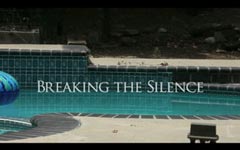The Reason I Jump, the book, has inspired The Reason I Jump, the documentary. The words of Naoki Higashida provide a kind of narration as the film follows the stories of five autistic young adults around the world, in the UK, Sierra Leona, India and the United States. The film is artistically rendered. It portrays the highly focused sensory experience of autistic people through close camera shots, examining water droplets and movements. It shows the autistic individuals and their families in life, and the overwhelmed emotions of autistic people in their effort to cope with sensory bombardment and frustration. The parents are wonderful. Only one of the autistic individuals is able to speak but his speech is not indicative of his ideas, in my opinion. He gets words out, but I suspect much more is trapped within. The young artist from India expresses herself through her art, but she has not been given a means to communicate through words. Still, she is conquering life through painting her ideas and feelings. The hardest life is in Sierra Leone. There, poverty and old superstitions make having a disability terrible for a family. One brave family started a school for autistic children and the happiness on the faces of the students was lovely to see. Their journey is long, but now they don’t need to be hidden by their families anymore.
The two Americans are able to communicate on letter boards. They learned this skill after years of silence, but they are now able to share their ideas with teachers and family, and they have a lot of feelings. I believe the others depicted in the film would benefit from communicating too. While the sensory system of people with autism is heightened, their need to be seen and heard as a person with ideas is equally high.
I had the opportunity to preview this film, soon to be released. People curious about autism should see it. It assumes competence, looks beyond odd behavior to see human beings struggling to deal with challenges and to cope with their messed up neurology. I was pleased with its honest but respectful portrayal. I send my good wishes to all who appeared in the film and hope this is the beginning of many changes for the silent warriors in this world.



